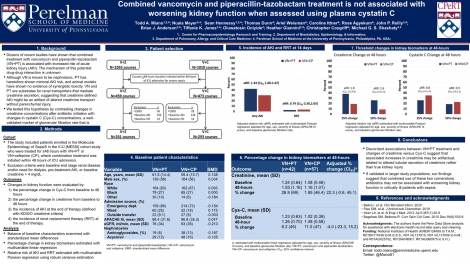Todd Miano
Combined vancomycin and piperacillin-tazobactam treatment is not associated with worsening renal function when assessed using plasma cystatin C
Abstract
Rationale: Although dozens of studies have associated combined vancomycin+piperacillin-tazobactam treatment (VN+PT) with increased acute kidney injury (AKI) risk, the mechanism of this drug-drug interaction remains unknown. AKI is defined based on changes in serum creatinine. VN and PT are substrates for kidney creatinine transporters, suggesting that creatinine defined AKI might be an artifact of altered creatinine transport. We tested this hypothesis by contrasting changes in creatinine with changes in cystatin C (Cys-C), a well-validated alternative marker of kidney function.
Methods: We performed a cohort study of patients with sepsis who were treated with VN+PT or VN+cefepime (CP), an active comparator. Changes in kidney function were evaluated by: 1) percentage change in Cys-C and creatinine from baseline to 48 hours; 2) creatinine-defined AKI at the end of therapy; and 3) renal replacement therapy (RRT) at the end of therapy.
Results: 534 patients were included (VN+PT n=241, VN+CP n=293), of whom 99 had Cys-C measurements (VN+PT n=42, VN+CP n=57). VN+PT was associated with a higher incidence of creatinine-defined AKI: 42.3% vs 30.4% (adjusted-RR 1.34 [CI95 1.08-1.67]); and a higher percentage increase of creatinine at 48 hours: 26.9% vs 1.9% (adjusted-difference 22.3% [-0.6-45.1]). In contrast, VN+PT was not associated with a change in Cys-C at 48 hours: 8.2% vs 11.0% (adjusted-difference -4.0% [-23.3-15.2]), or the need for RRT.
Conclusion: The discordant associations between VN+PT treatment and changes of creatinine versus Cys-C suggest that combined use of these cornerstone antibiotics may not be associated with worsening kidney function in critically ill patients with sepsis.
Keywords
acute kidney injury; nephrotoxicity; antibiotics; sepsis; drug-drug interactionsCommenting is now closed.
About Us
To understand health and disease today, we need new thinking and novel science —the kind we create when multiple disciplines work together from the ground up. That is why this department has put forward a bold vision in population-health science: a single academic home for biostatistics, epidemiology and informatics.
© 2023 Trustees of the University of Pennsylvania. All rights reserved.. | Disclaimer



